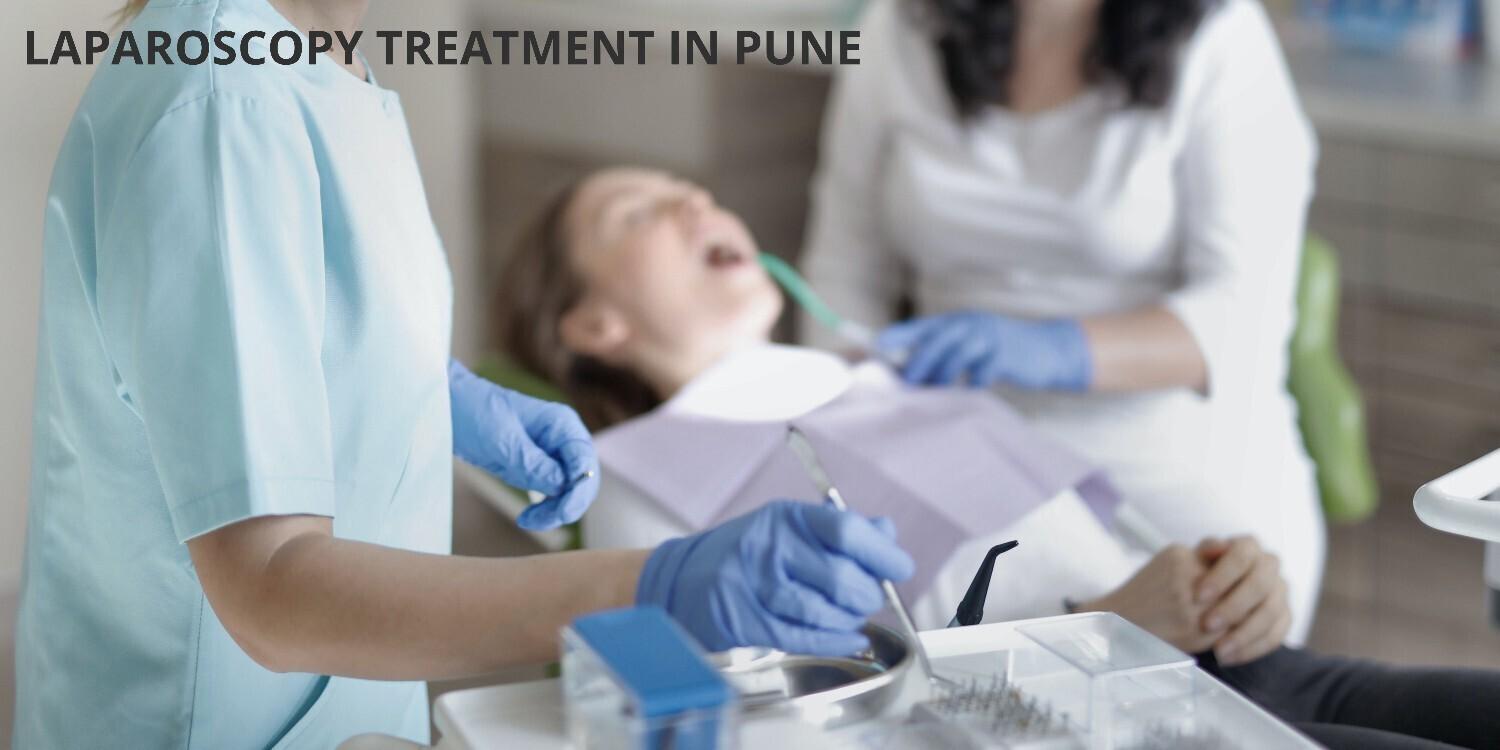Laparoscopy is an advanced technique for surgery keyhole surgery in Pune. The Fertility World- Nurturing Life in You! Is Ranked at the Top reviewed and Recommended Laparoscopy surgery in Pune. Pune’s top surgeon Dr. Kishor pandit is highly successful and the most renowned in India, with more than 20 years of experience operating the best treatment in Pune.
- Free First consultation: Book an appointment.
- Call us 919311850412 Email: info@fertilityworld.in
What is meant by Laparoscopy?
Laparoscopy means a surgical procedure in which a fiber-optic instrument is inserted through the abdominal wall to examine the organs inside the abdomen or permit small-scale surgery. This is also known by the name diagnostic laparoscopy. It is a low-risk, minimally invasive surgery which requires only keyhole incisions. Laparoscopy surgeons use an instrument called a laparoscope that allows them to access the inside of the abdomen and pelvis without having to make large incisions in the skin.
What is a Laparoscope?
A laparoscope is a long, thin tube with a high-intensity light and a high-resolution camera connected at the front. This long tube is inserted through a keyhole incision in the abdominal wall which relays images of the inside of the abdomen or pelvis to a video monitor of real-time. Which permits a surgeon to precisely carry out the surgery successfully. It also helps the Doctors for obtaining biopsy samples during the procedure.
What are the surgical procedures of laparoscopy?
Laparoscopy surgery is usually performed as an outpatient procedure under general anesthesia- you won’t feel any pain during the procedure and you’ll be able to go home the same day as your surgery completes. Laparoscopy can be performed in a hospital or at an outpatient surgical center.
During the procedure, these steps are followed:
- An intravenous (IV) line is inserted in one of your veins (right or left hand)- To achieve general anesthesia
- You’ll be injected with general anesthesia through the IV line, you’ll sleep through the procedures, and won’t feel any pain.
- In some cases, local anesthesia is used instead of general anesthesia. A local anesthetic numbs the area, so even though you’ll be awake during the surgery, you won’t feel any pain.
After injecting general or local anesthesia, the surgeon makes one or more small incisions of about 1 to 2-centimeter circumference below your belly button (abdomen) and then inserts a small tube called a cannula. Carbon dioxide gas is pumped into the abdomen via cannula for inflation of the abdomen which allows the doctor to examine your targeted abdominal organs more clearly and precisely in a real-time monitor that makes it easier for the surgeon to look around and operate freely.
After the abdomen area is created by pumping CO2 gas, the surgeon inserts the laparoscope through the other keyhole incision and reaches the targeted organs. The camera attached to the laparoscope displays the real-time images on a screen, which allows the surgeon to directly examine the diagnosis and achieve successful surgery or successful extraction of the samples for biopsy.
Generally, 1 to 4 keyhole incisions are made each between 1 to 2 centimeters in length. These incisions allow other instruments to be inserted if required. For example, your case needed to use another surgical tool to perform a biopsy. Biopsy: During a biopsy, they take a small sample of tissue from an organ to be evaluated.
Note:
The number and size of incisions depend upon the specific diseases the surgeon is targeting to confirm or rule out.
After the procedure is completed, the gas is let out of your abdomen and the instruments are removed. The incisions are then closed with stitches or surgical tape and dressing is applied. Bandages may be placed over the incisions. You can often go home on the same day after the laparoscopy procedure, or you may stay overnight in the hospital based on your health conditions.
Why is Laparoscopy performed? When is laparoscopy performed?
The medical technique of Laparoscopy is used to identify and diagnose a wide range of conditions that develop inside the abdomen or pelvis. It is also used to carry out surgical procedures, such as removing damaged or diseased organs or removing tissue samples for further testing (biopsy). It’s usually performed when non-invasive methods are unable to help with diagnosis or surgery.
Laparoscopy is most commonly applied in three kinds of treatments such as:
- Gynecology– to treat the conditions affecting female reproductive.
- Gastroenterology– to treat the conditions affecting the digestive system.
- Urology– to treat the conditions affecting the urinary system.
Laparoscopy is also performed to examine the problems associated with the following organs:
- Appendix
- Gallbladder
- Liver
- Pancreas
- Small intestine and large intestine (colon)
- Spleen
- Stomach
- Pelvic or reproductive organs
It detects such problems after examining the above organs. It detects the following problems:
- An abdominal mass or tumor
- Fluid in the abdominal cavity
- Liver disease
- The effectiveness of certain treatments
- The degree to which particular cancer has progressed
This diagnosis can be treated through laparoscopy immediately after its detection.
What other conditions can be diagnosed by laparoscopy?
Laparoscopy can diagnose the following conditions and can be treated the following problems:
- Female Infertility: Unable to carry pregnancy naturally.
- Ectopic pregnancy: Development of pregnancy outside the uterus.
- Ovarian cyst: Abnormal fluid-sac development in the female ovary(ies)
- Endometriosis: Lining of the endometrial tissues outside the uterus.
- Fibroids: Non-cancerous tumors that grow in or around the uterus.
- Undescended testicles: Common childhood condition where a boy is born without one or both testicles in their scrotum
- Appendicitis: Small pouch connected to the large intestine causes pain and swelling
- Pelvic inflammatory disease: A bacterial infection on the upper genital tract of the female (womb, fallopian tubes, and ovaries).
- Unexplained abdominal pain.
Laparoscopy is also used to diagnose different types of cancers, it helps to extract those suspected cancer cells samples for further testing in the laboratory.
Following cancers can be diagnosed:
- Pancreatic cancer
- Liver cancer
- Ovarian cancer
- Bile duct cancer
- Gallbladder cancer
Why is laparoscopy preferred rather than imagining techniques?
Laparoscopy is an absolute alternative medical procedure where imaging techniques cannot provide direct diagnostic problems in the abdominal area. It replaces an imaging technique such as:
- Ultrasound scan- uses high-frequency sound waves to create images of the body.
- Computerized tomography (CT) scan- a series of special X-rays that give cross-sectional images of the body.
- Magnetic resonance imagining (MRI) scan- uses magnets and radio waves to produce images of the body.
The only way to confirm a diagnosis is to directly study the affected part of the body using a laparoscope.
How Do You Prepare for Laparoscopy?
If you are taking any prescribed medication, over the counter, tell your doctor how you should continue. Your doctor can change the dose of any medications that could affect the outcome of laparoscopy. These drugs include:
- Anticoagulants (blood thinners).
- Nonsteroidal anti-inflammatory drugs (aspirin, Bufferin or ibuprofen, Advil, Motrin IB)
Other medications that affect blood clotting
- Herbal or dietary supplements
- Vitamin K
Based on your conditions for laparoscopy, you may not be allowed to eat or drink anything for 6 to 12 hours beforehand.
If you smoke, you will be advised to stop to avoid delayed recovery after laparoscopy. If you’re pregnant or possible, tell your laparoscopic doctor to avoid the risk of harming your developing fetus. Before the start of the procedure, you may undergo different tests such as:
- Blood tests
- Urinalysis
- Electrocardiogram(ECG)
- Chest X-ray
- Ultrasound
- CT scan
- MRI scan
These tests would help laparoscopic doctors to better understand the abnormality being examined during laparoscopy. The results also give your doctor a visual guide to the inside of your abdomen. You should also arrange for a family member or friend to drive you home after the procedure. Laparoscopy is often performed using general anesthesia, which can make you drowsy and unable to drive for several hours after surgery.
What are the benefits of laparoscopy?
Laparoscopy is beneficial in different ways over traditional methods of surgery, diagnosis, and complications. It is advantages because of the following reasons:
- Minimally Invasive, Painless Treatment
- Smaller Scars
- Lower Blood Loss
- Less Pain
- Short Hospital Stay
- Reduced Risk of Infections
- Faster Recovery
- 99% Successful treatment
- Lower cost
What are the complications or risks of Laparoscopy?
Laparoscopy may be associated with mild complications estimated to occur at the rate of 1% to 2% out of every 100 cases of treatment. It can include the following mild complication:
- Minor bleeding and bruising around the incision area
- Curable infection
- Feeling of sickness and vomiting.
Note:
- It will recover within a week or less.
- It is a commonly performed procedure and serious complications are rare
If you experience the following complication, no need to worry. Always contact your doctor, he/she will prescribe you the associated medication for quick recovery:
- Fevers or chills
- abdominal pain that becomes more intense over time
- Redness, swelling, bleeding, or drainage at the incision sites
- Continuous nausea or vomiting
- Persistent cough
- Shortness of breath
- Inability to urinate
- Lightheadedness
The Fertility World in PUNE is renowned and certified for its 1000+ successful laparoscopy treatments. It has ranked at the World-class level in laparoscopy. With 20+ years of experience in the field consisting of highly skilled specialists and world standard laboratories equipped with highly sophisticated instruments are winning the hearts of many patients in Pune and all across India, providing a very high success rate of 99%. One of the highest reviews by the previous patients is fully satisfied. Hundreds of patients are inflowing every day to get the opportunity for laparoscopy treatment at The Fertility World.
To Get Laparoscopy treatment at the lowest cost in Pune. Contact us today!



3 thoughts on “Laparoscopic Surgery in Pune | Best Surgeon Available in Pune”